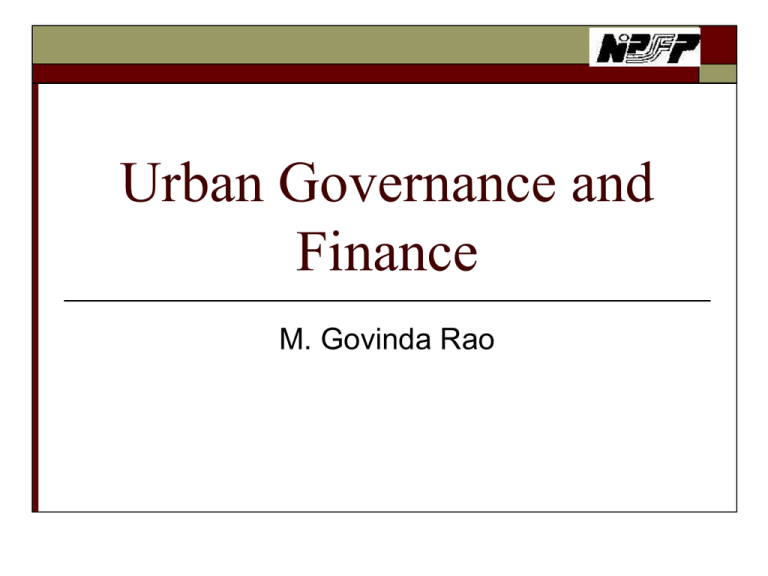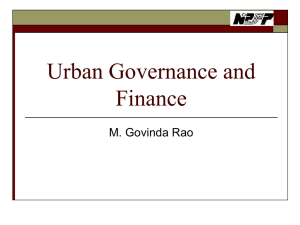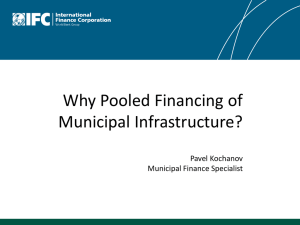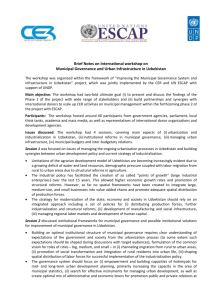Govinda Rao - International Growth Centre
advertisement

Urban Governance and Finance M. Govinda Rao Urban Governance and Finance: Introduction. Why is urban governance and finance a serious issue? What do we learn from fiscal federalism theories? Urban Governance in India. Expenditure assignment and financial management un urban local bodies. Financing Urban services: Own revenues. Financing urban services: Intergovernmental transfers. Financing Infrastructure spending. Concluding Remarks Introduction Need to study the issue of urban governance and public service delivery for a number of reasons: Innovation is the key to prosperity and most innovations occur in large cities due to interaction and exchange of ideas. Cities provide a critical mass to support high degree of division of labour, knowledge, business services, infrastructure, institutions and media. Globally competitive cities should provide a wide range of services to attract human capital: transportation, water, sewers garbage collection and disposal, police, fire protection, parks, recreation and culture, affordable housing and social assistance. Enabling the cities to be sources of dynamism is going to be the most important challenge. This requires examination of their governance structure and finance. Why Urban Governance and Finance is a Serious Issue in India? There are 139 municipal corporations, 1595 municipalities and 2108 Nagar panchayats. 3 of the 10 largest metropolises are in India (Mumbai, Delhi and Kolkata). Over 330 million people live in urban areas; 35 cities have over a million population; Contributes over two-thirds of GDP. Demand for services is large and growing. Resources inadequate; Actual spending (1999-2004) in 30 large cities was just about 24 per cent of the requirements. Underspending was over 75% in 17 municipal corporations. Under spending was over 50% in all except three. Poor coverage of urban amenities is recorded in the draft 11th Plan document as well. What do we learn from theories of fiscal federalism? Clarity in assignments and assignments should be according to comparative advantage: Objective is responsiveness and accountability; Depends on benefit span, diversity in demand, technology, capacity of the jurisdiction. Systems and institutions are necessary to effectively deal with overlapping assignments. Assigning responsibilities to different functionaries – Need to make the elected executive responsible for decision making. Need to separate the functions of the bureaucrat from the executive. Importance of governance systems. Finances should follow functions. “Wicksellian link” Matching revenue – expenditure decisions. Local governments should have productive tax handles. What do we learn from theories? Accountability requires that local services should be paid for locally and services with spillovers should receive matching transfers. Intergovernmental transfers are inevitable even as they soften the budget constraint. Need to design them properly to avoid perverse incentives. Ensuring a common market is at the heart of creating dynamism in fiscal federalism. Removal of impediments to mobility in factors and products and trade impediments to trade; Efficient factor (land, labour and capital) and product markets including credit and debt markets, institutional factors. Hard budget constraint is critical for efficiency and accountability; This requires clarity in assignments, avoidance of bail outs, avoidance of transfer dependency; development of markets; transparency in decision making. Governance Systems in India Four governance systems – one tier, two tier, voluntary cooperation and special purpose districts. Distinguish large from small metropolitan areas. Large metropolis: convert them into city-states to avoid restrictive protectionist policies (restrictions on factor and product markets for partisan reasons). Special capital districts; City States for large cities (Germany: Berlin, Munich and Frankfurt: China: Shanghai, Tianjin and Chongqing). Need to separate the roles of elected executive (Mayor) from the administrative head (Commissioner); need to make the officials accountable to the elected municipal government. Municipal Commissioner should be appointed by the municipal government (Expert Committee – Bangalore). Dual subordination does not work. Political interference by State and Central politicians. Planning for local governments: 243ZE – MPC. 243ZD – DPC; Ward sabhas; Not implemented in many states. Planning Commission mandated DPCs based on the recommendations of the Grassroots Planning Committee. 243S – Ward Committees in municipalities with more than 300000. The Report on Grassroots Planning has made useful recommendations. Need to Act on them. Expenditure Assignments and Financial Management Assignment Issues: Article 243 (W) devolves ULBs the powers. Twelfth Schedule lists 18 functions which are either in the state or concurrent list to be devolved at the discretion of the State government. Concurrency and overlapping. Omnibus list – and one size fits all approach to ULBs irrespective of the size. Still large corporations have been assigned more functions. Need for clear activity mapping exercises. States reluctance to transfer functions Independent service providers: lack of accountability. Responsibility is looked at independently from revenue sources. Public Financial Management: Comprehensive, comprehensible, verifiable, participatory and transparent municipal budget formulation, implementation and monitoring systems. Municipal control over revenues and expenditures; allocative autonomy. Capacity and incentives to operative efficiently. Improving local finance information system The system of financial oversight. Dealing with mistakes in autonomous municipalities. Municipal Revenues in India Reliable data are not available. Poor revenue collections: 12th FC (2001-02): Total revenue: 0.67% GDP; Own revenue: 0.38% GDP. (0.76% -NIPFP: Own revenue: 0.50% - tax – 0.38; user charges – 0.12%). (Brazil – Revenue 7.4%; Own revenue – 2.6%.) No separate tax schedule. Not surprising that there is large dependence on states and public service delivery is abysmal. Criteria for Tax Assignment Principles: Local governments should have revenue powers to finance public goods and levy user charges to finance merit goods. What is a local tax? Local governments should have powers to levy, collect and appropriate. Characteristics: (i) (ii) (iii) (iv) (v) (vi) (vii) Tax Base should be relatively immobile; Should be adequate and sufficiently buoyant; Tax yield should be stable and predictable; The tax should be borne by local residents; If mobile bases are to be taxed – it should be according to benefits received. It should to reasonably fair; Relatively easy to administer. User Charges Local governments of all sizes should charge for services (water, sewers, transit, recreation); ignored in practice; More important in large metropolitan areas. Charges should be according to marginal cost and not average cost unless, there is a specific objective. Some Commonly Assigned Taxes Residential Property Tax: Appropriate because (i) real property is immovable and (ii) there is a link between services provided and value of property. Non-residential property tax may be shifted to non-residents reduces accountability. Relatively costly to administer; Base - Capital value or rental value? Presumptive tax; Problem of administration – periodic valuation of properties Patna model is recommended – recent reform in Bangalore has several desirable features. Most property tax systems are antiquated. Low revenue productivity; poor incentives. Reforms on the lines of BBMP could triple the revenues. Some Commonly Assigned taxes Income tax – levied in 13 OECD countries – Piggybacking is the way forward. Payroll taxes (Mexico and South Africa) Vehicle and Fuel taxes (Bahl and Linn) – more suited at regional level. Sales Tax – GST – a separate surcharge. 1% additional rate could increase revenue by about 0.5% of GDP. Business taxes – distrotionary. Intergovernmental Transfers Own revenues hardly sufficient to finance local public services. Unavoidable. Unconditional grants: Given to enable adequate level of services at reasonable tax rates – based on capacities and needs. Most countries do not have such equalization grants. Specific purpose grants are given to finance the portion of local public service spilling over the boundaries. In India, the system varies from place to place. They are neither rational not adequate. Functioning of State Finance Commissions leaves much to be desired. Central finance commissions have largely confined themselves to giving lip service. Central finance Commission grants: 12th FC gave Rs. 4500 Crore during 2005-10 (of which Rs. 475.46 was not drawn). (Grants to augment water supply required covering 50% of maintenance through user charges). 13th FC: Giving a share in central taxes of the previous year varying from 1.5% to 2.5% . Basic Grant: 1.5% every year- Exclude special areas ( Rs. 20 per capita) - all states eligible. (population – 50%; area – 10%; Distance – 20%; Index of devolution – 15%; Sc/St pop – 5%) Performance grant effective 2011-12 - 0.5% to 1% if they fulfil 9 conditions: (i) (Supplement to the budget document on for local bodies and PRI s and urban local bodies should maintain accounts (as suggested in the National Municipal Accounts Manual). (ii) audit system for all local bodies; (iii) Ombudsman for local bodies (iv) Electronic fund transfer to local bodies within 5 days of receiving the money from the central government; (v) Specifying the qualifications of the members of SFC; (vi) enable local bodies to levy property tax (vii) property tax board; (viii) prescription of standards of essential services for local bodies; (ix) fire hazard response and mitigation plan for MCs with more than 1 million people. Specific Purpose Transfers: JNNURM and UIDSSMT Financing pattern: smaller cities - larger grant component. Reform component –particularly those relating to the freeing of land, labour and capital markets in JNNURM needs to be emphasized. Utilization rate is not encouraging – Need to provide publicity to create interest groups to demand funds from JNURM. Financing Infrastructure JNNURM: Important source of financing infrastructure. Services with nation-wide externalities should be financed from the Centre. Prevention of pollution to river water systems from the untreated sewerage discharge from municipal bodies on the banks of rivers. Borrowing Development Charges Is a good way to finance infrastructure. However, municipal bond markets have hardly developed in most developing countries. Even where it is developed, State government guarantees may be needed. Latin American countries have faced difficulties with imprudent borrowing. In the long run, it is necessary to loosen the restrictions on the, institute checks and balances and subject the municipalities to market disciple. Larger municipalities should be allowed to access markets with sufficient safeguards. Development charges collected by the developers. “Growth should pay for itself”; can act as marginal cost pricing. What about renewal? Proceeds from the sale of land and housing Financing Infrastructure Public Private partnerships. Models: Advantages: No upfront spending by municipal bodies; greater efficient and implementation capacity (lower unit costs); Private sector invests and collects charges on it over a specified time span. Both make investments and acquire rights for future income streams. Examples in India: Municipal solid waste management in Chennai – ONYX. Water supply in Hubli – Dharwar, Gulbarga and Belgaum by “Veolia Water”. Concluding Remarks The issue of urban governance and finance are paramount; They determine how the cities can accelerate the growth process as growth engines. The issues are complex and we can not find a solution for all systems. Both governance and finance issues will differ depending on different sizes of ULBs, different regions of the country. What is important is that broad principles should be kept in view in reform efforts. No one system of governance is universally applicable. The problems is with implementation. Need for clarity in functional assignment to local bodies and functionaries. Need to keep independent service providers with the overall control of executive. The paper explores several ways to augment revenues at the local level. Planning urban infrastructure and services requires compilation of considerable information. Karnataka is taking some lead in purring together the GIS. This is useful not only for planning but also to administer the taxes effectively.











